新视野大学英语(第三版)读写教程Book2-Unit4-电子教案
- 格式:doc
- 大小:42.00 KB
- 文档页数:5
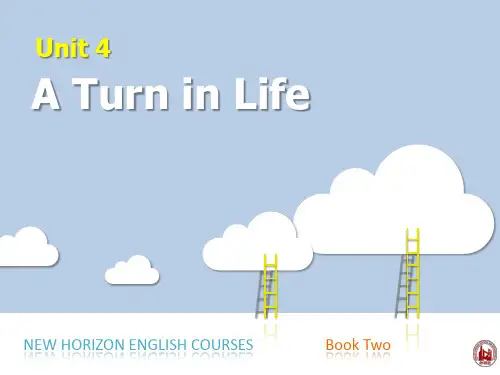

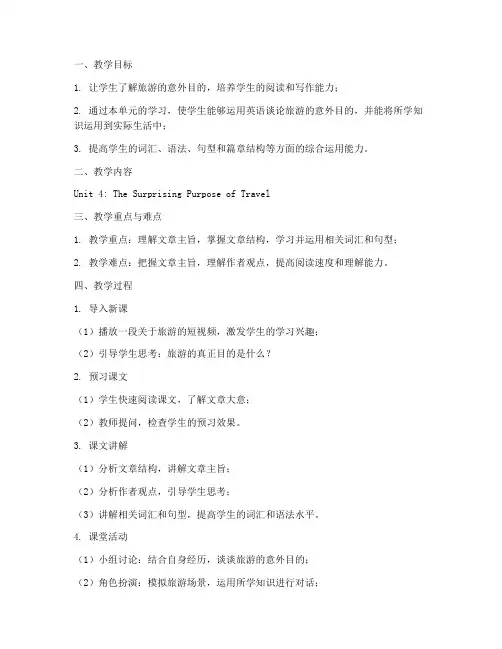
一、教学目标1. 让学生了解旅游的意外目的,培养学生的阅读和写作能力;2. 通过本单元的学习,使学生能够运用英语谈论旅游的意外目的,并能将所学知识运用到实际生活中;3. 提高学生的词汇、语法、句型和篇章结构等方面的综合运用能力。
二、教学内容Unit 4: The Surprising Purpose of Travel三、教学重点与难点1. 教学重点:理解文章主旨,掌握文章结构,学习并运用相关词汇和句型;2. 教学难点:把握文章主旨,理解作者观点,提高阅读速度和理解能力。
四、教学过程1. 导入新课(1)播放一段关于旅游的短视频,激发学生的学习兴趣;(2)引导学生思考:旅游的真正目的是什么?2. 预习课文(1)学生快速阅读课文,了解文章大意;(2)教师提问,检查学生的预习效果。
3. 课文讲解(1)分析文章结构,讲解文章主旨;(2)分析作者观点,引导学生思考;(3)讲解相关词汇和句型,提高学生的词汇和语法水平。
4. 课堂活动(1)小组讨论:结合自身经历,谈谈旅游的意外目的;(2)角色扮演:模拟旅游场景,运用所学知识进行对话;(3)写作训练:以“旅游的意外目的”为主题,写一篇短文。
5. 课堂小结(1)回顾本节课所学内容,总结重点和难点;(2)布置课后作业,巩固所学知识。
五、教学评价1. 课堂表现:观察学生在课堂上的参与度、积极性;2. 预习效果:检查学生的预习情况,了解学生对课文内容的掌握程度;3. 课堂活动:评估学生在课堂活动中的表现,如小组讨论、角色扮演等;4. 课后作业:检查学生的写作练习,了解学生的写作水平。
六、教学反思1. 教师应关注学生的个体差异,因材施教;2. 采用多种教学方法,激发学生的学习兴趣;3. 注重培养学生的阅读和写作能力,提高学生的英语综合素养。
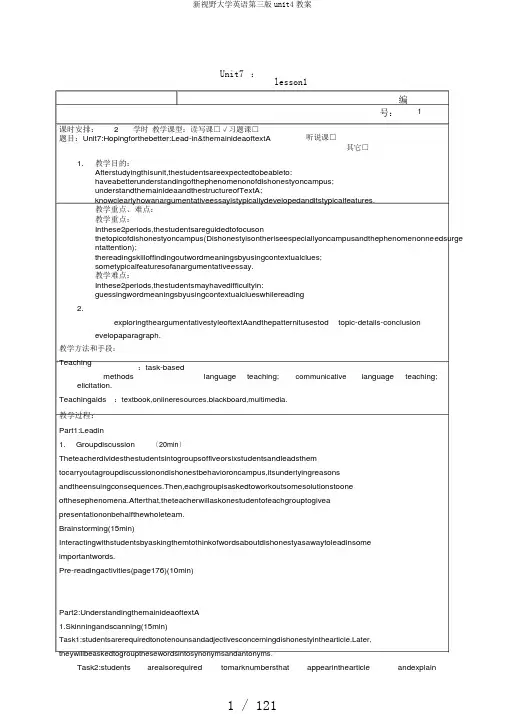
Unit7:lesson1编号:1课时安排:2学时教学课型:读写课□√习题课□题目:Unit7:Hopingforthebetter:Lead-in&themainideaoftextA听说课□其它□1.教学目的:Afterstudyingthisunit,thestudentsareexpectedtobeableto:haveabetterunderstandingofthephenomenonofdishonestyoncampus;understandthemainideaandthestructureofTextA;knowclearlyhowanargumentativeessayistypicallydevelopedanditstypicalfeatures.教学重点、难点:教学重点:Inthese2periods,thestudentsareguidedtofocusonthetopicofdishonestyoncampus(Dishonestyisontheriseespeciallyoncampusandthephenomenonneedsurge ntattention);thereadingskilloffindingoutwordmeaningsbyusingcontextualclues;sometypicalfeaturesofanargumentativeessay.教学难点:Inthese2periods,thestudentsmayhavedifficultyin:guessingwordmeaningsbyusingcontextualclueswhilereading2.exploringtheargumentativestyleoftextAandthepatternitusestodevelopaparagraph.topic-details-conclusion教学方法和手段:Teachingmethods :task-basedlanguage teaching;communicative language teaching;elicitation.Teachingaids:textbook,onlineresources,blackboard,multimedia.教学过程:Part1:Leadin1.Groupdiscussion〔20min〕Theteacherdividesthestudentsintogroupsoffiveorsixstudentsandleadsthem tocarryoutagroupdiscussionondishonestbehavioroncampus,itsunderlyingreasons andtheensuingconsequences.Then,eachgroupisaskedtoworkoutsomesolutionstoone ofthesephenomena.Afterthat,theteacherwillaskonestudentofeachgrouptogivea presentationonbehalfthewholeteam.Brainstorming(15min) Interactingwithstudentsbyaskingthemtothinkofwordsaboutdishonestyasawaytoleadinsome importantwords.Pre-readingactivities(page176)(10min)Part2:UnderstandingthemainideaoftextA1.Skinningandscanning(15min)Task1:ter, theywillbeaskedtogroupthesewordsintosynonymsandantonyms.Task2:students arealsorequired tomarknumbersthat appearinthearticle andexplainwhytheyareused.prehensionQs(page183)(15min)Part3Stylisticanalysis(15min)Concerning the writing style,t he students are guided to realize Text Ais an argumentative essay. Withregard toanargumentative essay, they shouldknowthewholetext centers onatopic andconcerning thetopic thewriter definitely hashis standpoint.Then concerningeachpartandeachparagraph,thestudentsareguidedtodiscoverthattheregenerallyisatopicsentence/statementsupportedbydetails(examplesinparticularinTextA)andaconcludingsentence/statement.板书设计:Unit7HopingforthebetterPart1.LeadinGroupdiscussionBrainstormingPre-readingactivitiesSkinningandscanningComprehensionQsPart3.Stylisticanalysis讨论、思考题、作业:PreviewthenewwordsandexpressionsoftextA;UtilizingtheinternetandgettoknowsomelifeexperiencesofAbrahamLincoln.Unit7:lesson2编号:2课时安排:2学时教学课型:读写课□√题目:Whenhonestydisappears:detailedstudyoftextA习题课□听说课□其它□教学目的:Afterstudyingthisunit,thestudentsareexpectedtobeableto:summarizethemainideaofTextA;understandthekeywords,phrases&expressions,andsentencestructures.教学重点、难点:教学重点:Inthese2periods,thestudentsareguidedtofocuson1.Keywords:eliminate;reveal;accurate;facilitate;exaggerate;imply;launch;frustrate;conscious;appropriate;expel;exemplify;extensive;awareness;etc.2.Phrases&expressions:launchacampaign;ifthis/thatisthe case;be confinedto;ripoff;descend to;turn in;copewith;nottomention;makeacomplaintaboutsth.;etc.3.Sentencestructures:Especially troubling/surprising/annoying are thereports/facts that.;Sth.,once hailedassth.,couldbecomesth.;Whetherdiscoveredornot(whetherconsciousorunconscious),sth.willdoaneffectonsth.;etc.教学难点:Inthese2periods,thestudentsmayhavedifficultyin:understandingthemainideaandstructureofTextA;; understandingandtranslatingsomecomplexsentences:教学方法和手段:Teaching methods:grammar translation teaching;communicative language teaching;elicitation.Teachingaids:textbook,onlineresources,blackboard,andmultimedia.教学过程:Part1Languagepoints(45min)Keywords:eliminatevt.1getridofsth.thatisnotwantedorneeded消除;剔除;铲除Wearetakingallmeasureswithinourpowertoeliminateviolence.我们正在采取我们力所能及的一切措施来消除暴力。
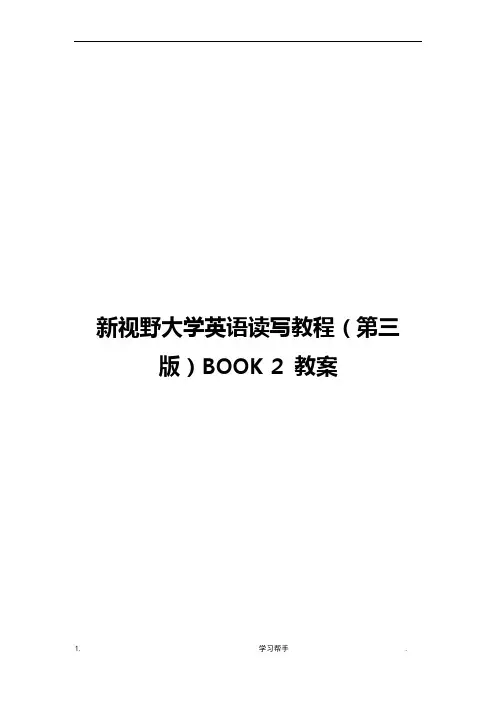

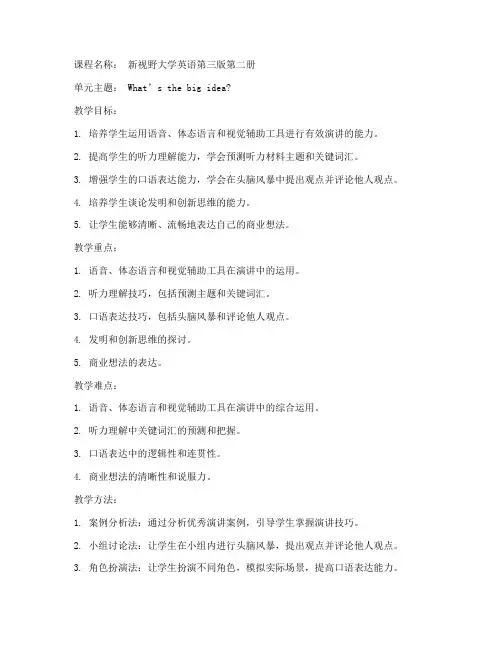
课程名称:新视野大学英语第三版第二册单元主题:What’s the big idea?教学目标:1. 培养学生运用语音、体态语言和视觉辅助工具进行有效演讲的能力。
2. 提高学生的听力理解能力,学会预测听力材料主题和关键词汇。
3. 增强学生的口语表达能力,学会在头脑风暴中提出观点并评论他人观点。
4. 培养学生谈论发明和创新思维的能力。
5. 让学生能够清晰、流畅地表达自己的商业想法。
教学重点:1. 语音、体态语言和视觉辅助工具在演讲中的运用。
2. 听力理解技巧,包括预测主题和关键词汇。
3. 口语表达技巧,包括头脑风暴和评论他人观点。
4. 发明和创新思维的探讨。
5. 商业想法的表达。
教学难点:1. 语音、体态语言和视觉辅助工具在演讲中的综合运用。
2. 听力理解中关键词汇的预测和把握。
3. 口语表达中的逻辑性和连贯性。
4. 商业想法的清晰性和说服力。
教学方法:1. 案例分析法:通过分析优秀演讲案例,引导学生掌握演讲技巧。
2. 小组讨论法:让学生在小组内进行头脑风暴,提出观点并评论他人观点。
3. 角色扮演法:让学生扮演不同角色,模拟实际场景,提高口语表达能力。
4. 任务驱动法:通过设计具体任务,引导学生运用所学知识进行实践。
教学步骤:一、导入1. 教师展示一些世界最差发明图片,引导学生讨论为什么这些发明被列入“世界最差发明”名单。
2. 引出单元主题:What’s the big idea?(什么是个大想法?)二、新课导入1. 学生阅读课文,了解单元主题和相关词汇。
2. 教师讲解重点词汇和语法结构。
3. 学生进行词汇和语法练习。
三、听力训练1. 学生听录音,预测听力材料主题和关键词汇。
2. 学生听录音,回答问题,检验听力理解能力。
3. 教师讲解听力材料,分析关键词汇和句子结构。
四、口语表达训练1. 学生进行头脑风暴,提出关于发明的创意想法。
2. 学生分组讨论,评论他人观点,并提出自己的看法。
3. 学生进行角色扮演,模拟实际场景,提高口语表达能力。

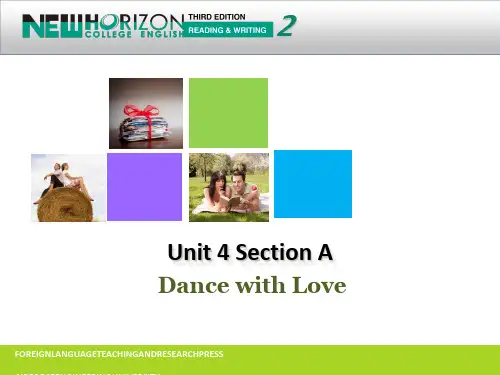

New Horizon College EnglishBOOK 2(3rd Edition)Unit 1 An Impressive English Lesson课型:□ 理论课√ 理论、实践课□ 实践课课时分配:6教学环境:多媒体教室教学目标:After studying this unit, the students are expected to be able to:1. understand the main idea and structure of Section A and Section B;2. master the key language points and grammatical structures in the texts3. talk about language teaching and learning and express their opinions about current way of teaching in an English class;4. read with the skill ―finding key ideas in sentences;5. write a composition with three main parts: introduction, body and conclusion.Key Issues:1. VocabularyTedious, absorbed, allergic, capture, condense, exceed, distinguish, distinctive, complimentary, complementary, proclaim, evidently, adequate, competent, adjust, beneficial2. SkillsLearn to read with the skill ―finding key ideas in sentences and write a composition with three main parts: introduction, body and conclusion.Potential Problems and Difficulties●To talk about language teaching and learning●write a composition with three main parts: introduction, body and conclusion.●To apply the phrases and patternsMethodology:A combination of traditional teaching methods with the communicative approach will be adopted. Special attention should be paid to classroom interaction like questioning and answers. Small group works are always needed while discussing the questions and the difficult translation practice. More encouragement is needed and more guidance will be given in their extracurricular study.Teaching Aids: Visual aids, projector, stereo and microphoneGroup work and pair workConduct of Tasks and Activities(师生互动方式Mode of Interaction; 学习策略Learning Strategies)Students-centered, Task-based teaching and learningTeaching ProceduresStep 1 Lead-inI. Greeting and warming-up questions discussion.1. What are the key factors that help people learn English as a foreign language?2. Do you have any problem in English learning?3. Do you think grammar is important in English learning?II. Listening and discussing.1. Listening practice.2. In your opinion, what is the most effective way to learn English?III. Listening to a talk and answer questions on page 2Step 2 Section A An Impressive English LessonI. Cultural background American university education1.What is Communicative Language Teaching?A type of teaching method;Develop the communicative ability as well as the knowledge of grammar; Learning by doing;Make classroom situation of real foreign language environment.2. What are the features of Communicative Language Teaching?Communicative competence is the goal;An integration of grammatical and functional teaching;Accuracy is secondary to conveying a message;Focus on communicative and contextual factors in language use;Learner-centered and experience-based.3. What is the role of teacher in Communicative Language Teaching?A facilitator of students’ learning;A manager of classroom activities;An advisor of students’ questions;A co-communicator in the communicative activity.II. Language PointsWords and expressions1. oddity: n. [C] a strange or unusual person or thing 怪人;怪物;奇特的东西With his neat suits on, he felt like an oddity walking in this poor neighborhood. 穿着笔挺的西装走在这个贫民区里,他觉得自己就像个怪物。

Book 2 Unit 4 College sweethearts教学重点:1.To talk about romantic love2.To learn and apply the words and phrases of the text3.Master the key language points and grammatical structures in the text教学难点:1.apply the phrases and patterns2.to listen and discuss the importance of humanities3.To critically think what makes wonder in their crisis—ridden marriage教学过程:Task 1Lead-in (Ss work in groups to discuss the following questions)1.What are the modern dating practices?Tips: casual dating, formal dating, speed dating, online dating, double dating,group dating,blind date…2. Do you think it’s a good idea to date someone at college? Why or why not? Tips: Yes, because:• it’s an ideal place to find someone who has the same aspirations.•through years of studying together, students get to know each other well。
• college has more choices than the workplace。
Unit 4 Section A College sweethearts1 I smile at my two lovely daughters and they seem so much more mature than we, their parents, when we were college sweethearts. Linda, who's 21, had a boyfriend in her freshman year she thought she would marry, but they're not together anymore. Melissa, who's 19, hasn't had a steady boyfriend yet. My daughters wonder when they will meet "The One", their great love. They think their father and I had a classic fairy-tale romance heading for marriage from the outset. Perhaps, they're right but it didn't seem so at the time. In a way, love just happens when you least expect it. Who would have thought that Butch and I would end up getting married to each other? He became my boyfriend because of my shallow agenda: I wanted a cute boyfriend!1 我微笑着看着我那两个可爱的女儿,她们似乎比她们的父母还是大学情侣那会儿更为成熟。